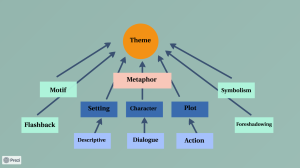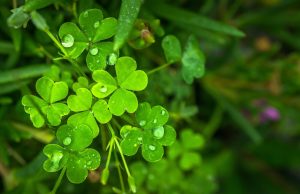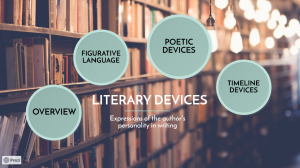6 Literary Devices
Learning Objectives
-
Identify figurative language and literary devices in fiction. Explain how authors use these tools to express their personalities.
-
Use metacognitive reading strategies before, during and after reading fiction, non-fiction and graphics.
Chapter & Discussion
This chapter includes a presentation that can be navigated in a classroom setting or independently. You can access the presentation via the link below.
Literary Devices: Expressions of Personality
Work through the different sections of the chapter and discuss ideas and topics as they arise. If you’re working independently, take notes instead. Notes and active discussion will be helpful in navigating this week’s assignments.
Literary Devices
Literary devices are expressions of an author’s personality in literature. They are the little tricks and fun elements that authors use to make the story (and experience) more interesting.
Because they help the author express their personality, they are also very good at communicating themes (the author’s big ideas- their messages and worldviews that they are trying to share by writing).

Another interesting aspect of literary devices is that they can communicate themes directly. They can be independent from other elements of literature, or they can work together with certain elements.
Figurative Language
Whenever you’re not speaking literally, you’re speaking figuratively. We do this a lot: to make comparisons and to have fun with language.
Authors use figurative language to express their personalities and share their ideas:
Metaphor
A metaphor is a poetic comparison:
- usually between very different things
- and usually seeing the second thing through the lens of the first
Metaphor is the primary way that people express their personalities. For this reason, it’s a major driving force of how literature works.
All figurative language (and most literary devices) are some kind of metaphor.
Symbolism
A type of metaphor where you relate something to an already well-known comparison in a culture or group.
For example, an eagle is considered a symbol for freedom and a four clover is a symbol for luck.

Poetic Devices
These literary devices help authors take advantage of the expressive and aesthetic characteristics of language.
Authors can use these to make a novel more like a poem at times.
Motif
A motif is a feature or phrase that repeats again and again throughout a story.
This can take the form of an image, a setting element, or a line of dialog. When we’re brought to something again and again, we stop and think critically about that element.
A repeated phrase can offer very powerful poetic resonance.
Alliteration
Alliteration is when the first letter of a word is repeated throughout a phrase.
This can make use of the beautiful qualities of language to be poetic or to make a point.

Timeline Devices
Authors often play with the timeline to express or reinforce their ideas.
Having a non-chronological timeline can help the reader to detach from the story and think critically about the big picture.
Foreshadowing
Foreshadowing is when the author gives us clues about what might happen in the future. This often happens at the end of a chapter.
It can help us to be more engaged by making us wonder about the big picture and the repercussions of choices down the line.
Flashback
A flashback breaks the timeline in order to give us a scene from a time before. This is often used to give the audience more perspective about a character and how they got to this point.
Authors can also flashforward, but it’s less common.
Assigned Reading
Here are this week’s readings. Additionally, please read for your own personal enjoyment for 1/2 hour each day. This will be called your “Reading Zone” reading and it will coincide with many upcoming activities.
What is Figurative Language? by Peter Betjemann (via Oregon State University)
What is a Metaphor? by Tim Jensen (via Oregon State University)
What is Symbolism? by Gilad Elbom (via Oregon State University)
Practice Set: Literary Devices
Click here to complete a practice set that explores concepts from the chapter.
These practice sets are designed to resemble the types of questions you’ll encounter on the GED RLA test. In this case, I am including a full novel chapter so that the reading can be engaging and so that you can have meaningful practice in the skill of close reading.
All of the practice sets in the Literature Unit will take on this format so that you can engage in enough practice to level up your reading skills while having access to literature that’s worth your time.
Assignment: Identifying Literary Devices (250 Words)
For each of the literary devices below, give an example from film, television, or literature.
-
Metaphor
-
Symbolism
-
Motif
-
Foreshadowing
-
Flashback
Pick four of your examples. What do you think the author is trying to do with these? What does it reveal about their personality? Does it help them communicate a theme?
Assignment: Reading Zone Response (250 Words)
For Reading Zone, you must find a novel that is interesting to you and enjoyable to read. If you need help finding a Reading Zone book, please ask. Please read your Reading Zone book for a half-hour each day. On class days, there will be time in class dedicated to reading.
Create a response to this week’s reading that addresses the following prompts:
-
In one paragraph, summarize what you’ve read this week
-
In a second paragraph, name three literary devices from this week’s RLA lesson that you’ve found in your book. Discuss one of these devices. How did you react to it?


